Stay Up to Date
Submit your email address to receive the latest industry and Aerospace America news.
The BepiColombo mission to Mercury, getting underway in October, could answer vexing questions about the innermost planet’s core and its Earth-like magnetic field. And the answers could shed light on planetary matters far beyond our solar system.
Mercury has long languished as the least-studied world in the inner solar system. To date, only two spacecraft — Mariner 10 in 1974 and MESSENGER in 2011 — have visited the remote, tiny, sun-scorched world. Helping to remedy that situation will be BepiColombo, a pair of probes scheduled for launch next month aboard an Ariane 5.
The mission is named after the late Italian physicist Giuseppe “Bepi” Colombo, who in the 1970s cracked how to glide a spacecraft into orbit around Mercury with planetary fly-bys. His namesake mission will initially consist of a four-part composite vessel — two orbiters, a cruise stage and a sunshield. The conjoined spacecraft will loop around Earth, Venus and finally Mercury multiple times to shave off velocity, lest it plummet right into the Sun. Finally, in late 2025, the two orbiters will separate and be captured into polar orbits by
Mercury’s gravity.
The probes — engineered to survive at least a year in the planet’s punishing environs — will then delve into Mercury’s ample scientific mysteries. In the process, the orbiters should fuel debates about how planets form and whether mechanisms might exist that would permit radiation-bathed exoplanets to support life, even if scientists are sure that Mercury itself has none.
Among the most pressing of Mercury’s mysteries is the precise size and composition of its relatively gargantuan core. Earth’s solid iron core fills less than 20 percent of our world’s volume. In Mercury’s case, however, coarse measurements from previous missions have ballparked its core as possibly taking up as much as a whopping 60 percent of planetary real estate, throwing a monkey wrench into theories of how planets form and evolve.
A second, related science objective will be to nail down the source of Mercury’s magnetic field. The other terrestrial planets, Venus and Mars, lack such a field; furthermore, Mercury’s field is surprisingly Earth-like, albeit weaker. Beyond its pure geophysics, the magnetic field interests astrobiologists because such fields are deemed critical for shielding planets’ surface biospheres (including Earth’s) from damaging solar radiation. Getting a better grip on Mercury should thus deliver key insights into the potential habitability of the multitude of exoplanets discovered in similarly tight orbits about their host stars.
“Mercury plays a special role in the solar system,” says Johannes Benkhoff, the BepiColombo project scientist for the European Space Agency, or ESA, which spearheads the mission along with the Japan Aerospace Exploration Agency, known as JAXA. The planet closest to the sun, Benkhoff says, is a unique, yet so-far-underused laboratory.
Taking the heat
To be clear, Mercury is in no way a contender for harboring life in any form, owing to its lack of an atmosphere and searing temperatures. For the BepiColombo mission, those temperatures pose the toughest challenge to securing high-quality science returns. “Thermal design has been the biggest hurdle,” says Masaki Fujimoto, the JAXA BepiColombo project scientist.
Depending on where Mercury is in its orbit, the planet is blasted by more than 10 times the solar irradiation we receive at Earth. This results in a maximum temperature on Mercury’s surface of about 450 degrees Celsius (850 degrees Fahrenheit). As Ulrich Reininghaus, the ESA BepiColombo project manager, points out, that “is the temperature achieved in the best wood-fired Neapolitan pizza ovens.”
Dealing with these pizzeria-esque temperatures required innovations for the MPO, short for Mercury Planetary Orbiter — the bigger of the two BepiColombo orbiters, weighing in at 1,150 kilograms. For starters, to avoid temperature buildup and heat damage, MPO’s solar arrays will continuously swivel, keeping the sun at a low angle while still catching enough rays for power generation. As for spacecraft insulation, engineers at Airbus — the prime contractor on BepiColombo — realized that conventional polymers would not suffice for that role. They accordingly developed a new, 50-layer blanket of ceramic fabrics and aluminum sheets. Those blankets wrap around all MPO surfaces, except for a 3.7-meter-wide radiator that always faces away from the sun. Reininghaus explains that all internal heat dissipation, as well as external heat that will inevitably leak through the insulation, is conveyed to this radiator by heat pipes for subsequent shedding into space. In addition, titanium louvers on the radiator’s surface will reflect away the intense heat coming up from Mercury.
Overall, this temperature-moderating architecture will allow MPO to descend to low Mercurian altitudes — below 500 kilometers during the closest passes — where it will scrutinize the whole planet at closer range than Mariner 10 and MESSENGER, enabling the characterization of Mercury’s crater-pockmarked surface in unprecedented detail with its two cameras and six spectrometers.
Looking within
Counterintuitively, gathering all this surface data will be crucial for seeing what is deep inside Mercury. Monitoring features on Mercury will reveal how the planet wobbles in its orbit around the sun. That, along with precision radio tracking of MPO’s orbits to map Mercury’s gravitational field, will determine the distribution of mass throughout the planet’s crust, mantle and core. With this data in hand, scientists can better answer if Mercury’s big core was there from birth, so to speak, and is therefore a natural, though poorly explained outcome of planet formation. Alternately, the data could support the popular theory that a cataclysmic collision with another body early in the solar system’s history blew away most of Mercury’s original crust and mantle.
The MPO data will also speak to how much of Mercury’s internal mass is in solid or liquid form. This distinction matters for identifying the mechanism behind Mercury’s magnetic field. Earth’s magnetic field is generated by a liquid outer core in which the motion of electrically conducting molten iron creates the equivalent of a planet-scale bar magnet. Mercury’s innards could be something else entirely. Measurements from MESSENGER of Mercury’s northern hemisphere found that the magnetic field is strongly asymmetrical, unlike Earth’s. BepiColombo will fill in missing southern hemisphere data, offering the fullest portrait to date of the enigmatic field. “Is there a different way of situating an electromagnet inside a rocky planet?” asks JAXA’s Fujimoto. “There is a reasonable expectation that it is different.”
JAXA’s BepiColombo orbiter, the smaller, 275-kg Mercury Magnetospheric Orbiter or MMO, will assist by measuring field shape and strength at distances of up to nearly 12,000 kilometers from Mercury, complementing MPO’s closer-in measurements. To survive the Mercurian inferno, MMO relies on different strategies than its partner, MPO. For heat distribution, MMO spins, rotisserie-style, at 15 revolutions per minute. Its octagonal body has a polished mirrored surface to reflect excess sunlight that is not needed by MMO’s rows of solar cells for conversion to electricity.
Life elsewhere
The lessons learned about Mercury by BepiColombo will shed light on how all planets form and especially how they evolve under the withering glare of an encroaching star. One particular application will be to exoplanets around M stars, also called red dwarfs, which make up four of every five stars in the universe. Though dimmer than the sun, M stars flare more, unleashing bursts of radiation. These flares could sterilize any temperate worlds in orbits sufficiently close enough for life-enabling water to remain liquid on their surfaces. “The space environment of habitable planets around M stars is far more harsh than what we study in detail at Earth,” says Fujimoto.
Protective magnetic fields, akin to Mercury’s though stronger in magnitude, could just be what gives life a chance.
Mercury’s maximum surface temperature of about 450 degrees Celsius (850 degrees Fahrenheit) “is the temperature achieved in the best wood-fired Neapolitan pizza ovens.”
Ulrich Reininghaus, ESA BepiColombo project manager
About Adam Hadhazy
Adam writes about astrophysics and technology. His work has appeared in Discover and New Scientist magazines.
Related Posts
Stay Up to Date
Submit your email address to receive the latest industry and Aerospace America news.






